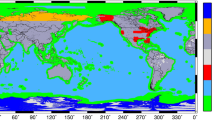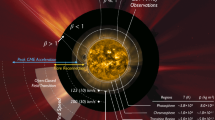Abstract
We use Open Geospace General Circulation Model (OpenGGCM) simulations to predict magnetic field perturbations at Low Earth Orbiting (LEO) satellites such as Swarm, at high latitudes. The simulations allow us to separate three different major contributions to the observed perturbations, i.e., the perturbations caused by currents in the outer magnetosphere, field-aligned currents (FACs), and the currents flowing in the ionosphere. We find that at an altitude of 500 km the strongest contribution comes from FACs, followed by the perturbations caused by the ionospheric currents, while the magnetospheric currents make only a minor contribution. The high latitude perturbations do not average out over extended quiet time periods. There are significant variations in the patterns; however, on a large scale, the basic shape of the pattern remains stable. Thus, without explicitly removing the perturbations from the data, any spherical harmonics fit is expected to incur a bias. Although the predicted OpenGGCM perturbations do not compare particularly well with Swarm data, the simulations reproduce the overall pattern. However, they may still be useful to reduce the bias of the ensemble and produce better global spherical harmonic fits, by producing an ensemble whose external field contributions average out. Since this paper only scratches the surface of the role that models of the external field can play in producing unbiased internal field models, much progress is still possible, for example by improving the external model, investigating larger ensembles, and by considering data from geomagnetically disturbed times.








Similar content being viewed by others
References
B.J. Anderson, H. Korth, C.L. Waters, D.L. Green, P. Stauning, Statistical Birkeland current distributions from magnetic field observations by the iridium constellation. Ann. Geophys. 26, 671–687 (2008)
V. Angelopoulos et al., Tail reconnection triggering substorm onset. Science 321, 931 (2008)
D.N. Baker, T.I. Pulkkinen, V. Angelopoulos, W. Baumjohann, R.L. McPherron, Neutral line model of substorms: past results and present view. J. Geophys. Res. 101, 12,975 (1996)
J. Berchem, J. Raeder, M. Ashour-Abdalla, Magnetic flux ropes at the high-latitude magnetopause. Geophys. Res. Lett. 22, 1189 (1995)
J.U. Brackbill, D.C. Barnes, The effect of nonzero div B on the numerical solution of the magnetohydrodynamic equations. J. Comp. Physiol. 35, 426 (1980)
J.C. Dorelli, A. Bhattacharjee, J. Raeder, Separator reconnection at Earth’s dayside magnetopause under generic northward interplanetary magnetic field conditions. J. Geophys. Res. 112, 1 (2007). doi:10.1029/2006JA011877
C.R. Evans, J.F. Hawley, Simulation of magnetohydrodynamic flows: a constrained transport method. Astrophys. J. 332, 659 (1988)
J.A. Fedder, J.G. Lyon, The solar wind–magnetosphere–ionosphere current–voltage relationship. Geophys. Res. Lett. 14, 880 (1987)
C.C. Finlay et al., International geomagnetic reference field: the eleventh generation. Geophys. J. Int. 183, 1216–1230 (2010)
T.J. Fuller-Rowell, D. Rees, S. Quegan, R.J. Moffett, M.V. Codrescu, G.H. Millward, A coupled thermosphere–ionosphere model (CTIM), in STEP Report, ed. by R.W. Schunk. Scientific Committee on Solar Terrestrial Physics (SCOSTEP) (NOAA/NGDC, Boulder, 1996), p. 217
Y.S. Ge, J. Raeder, V. Angelopoulos, M.L. Gilson, A. Runov, Interaction of dipolarization fronts within multiple bursty bulk flows in global MHD simulations of a substorm on 27 February 2009. J. Geophys. Res. 116, A00I23 (2011)
A. Harten, G. Zwas, Self-adjusting hybrid schemes for shock computations. J. Comput. Phys. 9, 568 (1972)
C. Hirsch, Numerical Computation of Internal and External Flow, vol. II (Wiley, New York, 1990)
T. Ijima, T.A. Potemra, Field-aligned currents in the day side cusp observed by Triad. J. Geophys. Res. 81, 5971 (1976)
M.C. Kelley, The Earth’s Ionosphere (Academic Press, New York, 1989)
S. Knight, Parallel electric fields. Planet. Space Sci. 21, 741 (1972)
C.B. Laney, Computational Gasdynamics (Cambridge University Press, Cambridge, 1998)
G. Le, J. Raeder, C.T. Russell, G. Lu, S.M. Petrinec, F.S. Mozer, Polar cusp and vicinity under strongly northward IMF on April 11, 1997: observations and MHD simulations. J. Geophys. Res. 106, 21,083 (2001)
W. Li, J. Raeder, J.C. Dorelli, M. Thomsen, B. Lavraud, Solar wind entry into the magnetosphere under northward IMF conditions. J. Geophys. Res. 113, A04204 (2008)
W. Li, J. Raeder, M. Øieroset, T.D. Phan, Cold dense magnetopause boundary layer under northward IMF: results from THEMIS and MHD simulations. J. Geophys. Res. 114, A00C15 (2009). doi:10.1029/2008JA013497497
W. Li, D. Knipp, J. Lei, J. Raeder, The relationship between dayside local Poynting flux enhancement and cusp reconnection. J. Geophys. Res. 116, A08301 (2011). doi:10.1029/2011JA016566
A.T.Y. Lui, Extended consideration of a synthesis model for magnetic substorms, in Magnetospheric Substorms, ed. by J.R. Kan, T.A. Potemra, S. Kokubun, T. Ijima. AGU Monogr. Ser., vol. 64 (Am. Geophys. Union, Washington, 1991), p. 43
R.L. McPherron, Physical processes producing magnetospheric substorms and magnetic storms, in Geomagnetism, vol. 4, ed. by J. Jacobs (Academic Press, San Diego, 1991), p. 593
R.L. McPherron, The role of substorms in the generation of magnetic storms, in Magnetic Storms, ed. by B.T. Tsurutani, W.D. Gonzalez, Y. Kamide, J.K. Arballo. AGU Monogr. Ser., vol. 98 (Am. Geophys. Union, Washington, 1997), p. 131
R.L. McPherron, C.T. Russell, M.P. Aubry, Satellite studies of magnetospheric substorms on August 15, 1968, 9. Phenomenological model for substorms. J. Geophys. Res. 78, 3131 (1973)
T. Moretto, S. Vennerstrom, N. Olsen, L. Rastaetter, J. Raeder, Using global magnetospheric models for simulation and interpretation of Swarm external field measurements. Earth Planets Space 58, 439–449 (2006)
N. Olsen, H. Lühr, T.J. Sabaka, M. Mandea, M. Rother, L. Toffner-Clausen, S. Choi, CHAOS—a model of the Earth’s magnetic field derived from CHAMP, Orsted, and SAC-C magnetic satellite data. Geophys. J. Int. 166, 67–75 (2006)
N. Olsen, C. Stolle, Space Sci. Rev. (2016). doi:10.1007/s11214-016-0279-7
A. Pulkkinen et al., Geospace environment modeling 2008–2009 challenge: ground magnetic field perturbations. Space Weather S02, 004 (2011)
A. Pulkkinen et al., Community-wide validation of geospace model ground magnetic field perturbation predictions to support model transition to operations. Space Weather 11, 369 (2013). doi:10.1002/swe.20056
J. Raeder, Global Magnetohydrodynamics—A Tutorial, in Space Plasma Simulation, ed. by J. Büchner, C.T. Dum, M. Scholer (Springer, Berlin/Heidelberg/New York, 2003)
J. Raeder, Flux transfer events: 1. Generation mechanism for strong southward IMF. Ann. Geophys. 24, 381 (2006)
J. Raeder, J. Berchem, M. Ashour-Abdalla, The importance of small scale processes in global MHD simulations: some numerical experiments, in The Physics of Space Plasmas, vol. 14, ed. by T. Chang, J.R. Jasperse (MIT Cent. for Theoret. Geo/Cosmo Plasma Phys., Cambridge, 1996), p. 403
J. Raeder, J. Berchem, M. Ashour-Abdalla, The geospace environment modeling grand challenge: results from a global geospace circulation model. J. Geophys. Res. 103, 14,787 (1998)
J. Raeder, O. Vaisberg, V. Smirnov, L. Avanov, Reconnection driven lobe convection: interball tail probe observations and global simulations. J. Atmos. Sol.-Terr. Phys. 62, 833 (2000)
J. Raeder, Y.L. Wang, T.J. Fuller-Rowell, Geomagnetic storm simulation with a coupled magnetosphere–ionosphere–thermosphere model, in Space Weather, AGU Geophys. Monogr. Ser., vol. 125, ed. by P. Song, G. Siscoe, H.J. Singer (Am. Geophys. Union, Washington, 2001a), p. 377
J. Raeder, Y.L. Wang, T.J. Fuller-Rowell, H.J. Singer, Global simulation of space weather effects of the Bastille Day storm. Sol. Phys. 204, 325 (2001b)
J. Raeder, D. Larson, W. Li, E.L. Kepko, T. Fuller-Rowell, OpenGGCM simulations for the THEMIS mission. Space Sci. Rev. 141, 535 (2008)
J. Raeder, P. Zhu, Y. Ge, G.L. Siscoe, OpenGGCM simulation of a substorm: axial tail instability and ballooning mode preceding substorm onset. J. Geophys. Res. 115, A00l16 (2010)
J. Raeder, P. Zhu, Y. Ge, Auroral signatures of ballooning mode near substorm onset: OpenGGCM simulations, in Auroral Phenomenology and Magnetospheric Processes: Earth and other Planets, ed. by A. Keiling, E. Donovan, F. Bagenal, T. Karlsson. AGU Geophysical Monograph, vol. 197 (2012), pp. 389–395
L. Rastaetter, M. Hesse, M. Kuznetsova, J.B. Sigwarth, J. Raeder, T.I. Gombosi, Polar cap size during 14–16 July 2000 (Bastille Day) solar coronal mass ejection event: MHD modeling and satellite imager observations. J. Geophys. Res. 110, A07212 (2005). doi:10.1029/2004JA010672
L. Rastatter et al., Geospace environment modeling 2008–2009 challenge: Dst index. Space Weather 11, 187 (2013). doi:10.1002/swe.20036
H. Rishbeth, W. Deng, R.G. Roble, T.L. Killeen, A.G. Burns, The flywheel effect: ionospheric currents after a geomagnetic storm. Geophys. Res. Lett. 18, 1845 (1991)
P. Ritter, H. Lühr, S. Maus, A. Viljanen, High-latitude ionospheric currents during very quiet times: their characteristics and predictability. Ann. Geophys. 22 2001 (2004)
G. Rostoker, Effects of substorms on the stormtime ring current index \(\mathit{Dst}\). Ann. Geophys. 18, 1390–1398 (2000)
C.T. Russell, Y.L. Wang, J. Raeder, The interplanetary shock of September 24, 1998: arrival at Earth. J. Geophys. Res. 105, 25,143 (2001)
B.U.O. Sonnerup, L.J. Cahill, Magnetopause structure and attitude from Explorer 12 observations. J. Geophys. Res. 72, 171 (1967)
B.U.O. Sonnerup, L.J. Cahill, Explorer 12 observations of the magnetopause current layer. J. Geophys. Res. 73, 1757 (1968)
R.J. Strangeway, J. Raeder, On the transition from collisionless to collisional magnetohydrodynamics. J. Geophys. Res. 106, 1955 (2001)
G. Toth, The \(\nabla{\cdot} B\) constraint in shock-capturing magnetohydrodynamics codes. J. Comp. Physiol. 161, 605 (2000)
V.M. Vasyliunas, Mathematical models of magnetospheric convection and its coupling to the ionosphere, in Particles and Fields in the Magnetosphere (Reidel, Dordrecht, 1970), p. 61
V.M. Vasyliunas, Electrodynamics of the ionosphere/magnetosphere/solar wind system at high latitudes, in NATO Advanced Studies Inst., Lillehammer (1988)
S. Vennerstrom, T. Moretto, L. Rastaetter, J. Raeder, Field-aligned currents during northward interplanetary field: morphology and causes. J. Geophys. Res. 110, A06205 (2005). doi:10.1029/2004JA010802
S. Vennerstrom, T. Moretto, L. Rastaetter, J. Raeder, Modeling and analysis of solar wind generated contributions to the near-Earth magnetic field. Earth Planets Space 58, 451–461 (2006)
D.R. Weimer, An improved model of ionospheric electric potentials including substorm perturbations and application to the Geospace Environment Modeling November 24, 1996, event. J. Geophys. Res. 106, 407 (2001)
R.A. Wolf, The quasi-static (slow flow) region of the magnetosphere, in Solar Terrestrial Physics, ed. by R.L. Carovillano, J.M. Forbes (Reidel, Hingham, 1983), p. 303
S.T. Zalesak, Fully multidimensional flux-corrected transport. J. Comp. Physiol. 31, 355 (1979)
S.T. Zalesak, Very high order pseudospectral flux-corrected transport (FCT) algorithms for conservation laws, in Proceedings of the Fourth IMACS International Symposium on Computer Methods for Partial Differential Equations, ed. by R. Vichnevetsky, R.S. Stepleman (IMACS, Rutgers University, New Brunswick, 1981), p. 126
P. Zhu, J. Raeder, C.C. Hegna, C.R. Sovinec, Nature of axial tail instability and bubble-blob formation in near-Earth plasma sheet. J. Geophys. Res. 118, 1–11 (2013). doi:10.1029/2012JA017972
Acknowledgements
The authors would like to thank the conveners of the ISSI workshop Earth Magnetic Field: Understanding Sources from the Earth’s Interior and its Environment Claudia Stolle, Nils Olsen, Art Richmond, and Hermann Opgenoorth, who inspired this research. The work at UNH was funded through grant AGS-1143895 from the National Science Foundation, and NASA/LWS grant NNX13AK31G. Computations were performed on Trillian, a Cray XE6m-200 supercomputer at UNH supported by the NSF MRI program under grant PHY-1229408.
Author information
Authors and Affiliations
Corresponding author
Rights and permissions
About this article
Cite this article
Raeder, J., Cramer, W.D., Germaschewski, K. et al. Using OpenGGCM to Compute and Separate Magnetosphere Magnetic Perturbations Measured on Board Low Earth Orbiting Satellites. Space Sci Rev 206, 601–620 (2017). https://doi.org/10.1007/s11214-016-0304-x
Received:
Accepted:
Published:
Issue Date:
DOI: https://doi.org/10.1007/s11214-016-0304-x




